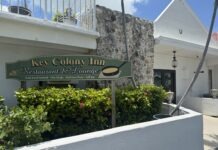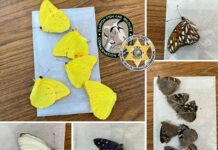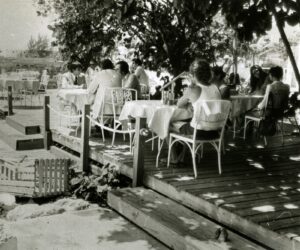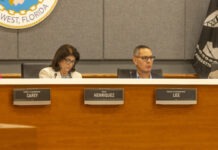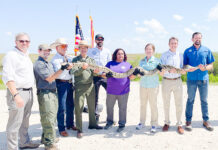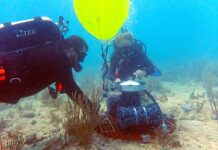If you are not following my Facebook group, Florida Keys History with Brad Bertelli, then you are missing out on daily doses of great local history. One thing that makes the group special is how many photographs, memories and insights are shared in the posts.
With more than 24,000 members, it has become a fantastic platform to share these island histories. It has also become a place where I learn new and interesting pieces of information. A recent post featuring the picture of these men and that boy displaying their catch on Pigeon Key circa 1920 inspired a lively discussion after I referred to the crustaceans piled into the wheelbarrows as crawfish and not spiny lobster.
Technically, the crustaceans are Panulirus argus, the Caribbean spiny lobster. In the Sunshine State, they are more commonly called Florida spiny lobster. As larvae, they are at the whimsy of the currents before settling in the seagrass and algae beds that act as their nurseries. It takes about two years for a lobster to grow to a legal size with a carapace measuring 3 inches long.
Left unmolested by sharks, turtles or fishermen, the spiny lobster can reach up to 15 pounds. The spiny lobster is one of the most commercially important species harvested to support the local seafood industry. It is rare to find the really big ones like those pictured in the wheelbarrows any more. Though considered a commercially sustainable species, no fishery is what it used to be.
Like many pioneers who carved out a way of life in the Florida Keys, William Dunham and Mary Jane Albury left the Bahamas and settled in Key West. In 1886, they left the Southernmost City with their 3-week-old son, William Beauregard, and settled in the Rock Harbor area of Key Largo. The family farmed pineapples until a blight and competition from Cuban farmers took its toll on the Keys’ pineapple industry.
The Albury pineapple farm was replaced with groves of Key lime trees. In 1913, Beauregard and his father constructed a conch-style wooden house. In those days, the Albury home would have been located just south of the Over-Sea Railroad’s Rock Harbor Depot. Today, it sits in the exact same place as it did when it was built. It represents the oldest house on Key Largo that still stands in its original locale and is now home to the Reef Environmental Education Foundation at MM 98.
The Alburys were farmers, but they were also fishermen. One of the species they “fished” for was spiny lobster – although, in the old days, the crustaceans were referred to as crawfish, not lobster, as is demonstrated in this portion of an interview with Beauregard Albury that appeared in the book “Key Largo/Island Home” published in 1967 by the Key Largo Foundation.
Albury said, “You should have seen the crawfish in the mangrove roots along the shores. They were stacked up two feet — one on top of the other. I’ve had them weigh seven pounds. The whole shore would be red, two or three hundred feet. One time I caught 2,900 crawfish with a small net. My father had a contract with the railroad to supply crawfish to Key West. The last season we worked for them, we shipped 54,000 pounds even though the supply was depleted by that time. That was the only year we kept a record. We found most of them on the lee side of Key Largo, Rodriguez and Tavernier — wherever there was a mangrove shore. Nothing much on Dove Key.”
It was not just the pioneers who called lobster crawfish, as evidenced by a series of newspaper advertisements and articles. For instance, the Dec. 1, 1921 edition of the Sarasota County Times advertised, “For French Oysters and Key West Crawfish go to Silva’s Market”.
The Dec. 22, 1928 edition of the Key West Citizen printed the menu for Key West’s Manhattan Café featuring “All American Cooking.” The menu listed “Broiled Key West Crawfish with French Fried Potatoes for 65 cents and Crawfish a la King with Mashed Potatoes for 75 cents.” The Key West Citizen printed a different kind of reference to crawfish in its Sept. 21, 1933 edition. The opinion in the paper addressed the controversial Louisiana politician who was assassinated two years later. “We Key Westers object to Huey Long being termed the ‘Crawfish.’ In Key West, crawfish are considered a delicacy and are far superior to the unsavory antics of Louisiana’s senatorial mistake. ‘Jellyfish’ would be more descriptive.”
It was not just the old-timers who referred to lobster as crawfish in South Florida and the Keys. In a story about Key West’s favorite son, a then up-and-coming coconut troubadour named Jimmy Buffett, crawfish was the identifier used when talking about the tasty lobster.
In the Feb. 3, 1974 edition of the Fort Pierce News Tribune, a story appeared with the headline “Country Singer ‘Buffetting’ To Top.” “When he’s not performing or recording, Buffett relaxes with friends or chugs off in his little Boston whaler to check some crawfish and stone crab traps. … His first album, released last summer, is called ‘A White Sport Coat and A Pink Crustacean.’ On the album cover Buffett is posed before a Key West crawfish boat with a crate of the creatures. He and his friend, the photographer, ate the crawfish after a day spent shooting the cover.”
While crawfish is not the official name of the Caribbean spiny lobster, it is certainly a local variant in South Florida and the Keys and has been for a very long time. In fact, the Merriam-Webster Dictionary lists two definitions of crawfish: crayfish and spiny lobster.




